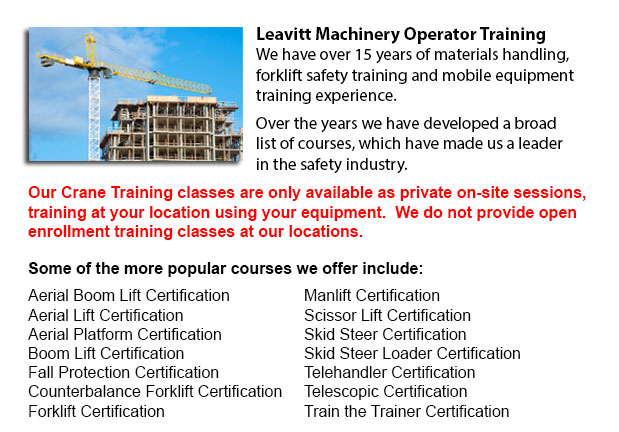
Overhead Crane Safety Training Surrey - Overhead crane safety training equips operators with skills and knowledge regarding crane safety measures, materials handling, accident avoidance, and machinery and stock protection. Trainees will learn the types of overhead cranes, their capabilities and their uses in various industry settings. For operators who are trained and licensed, the shift in liability moves from the company to the operator. Therefore, the program emphasizes individual operator responsibilities.
The operators in the overhead safety training program would receive instruction about the proper ways for doing checks: the more detailed in-depth inspection and the pre-shift inspection. These are critical daily routines which should be logged. Properly recorded pre-shift inspections help to protect the company from liability in the event of an accident. Pre-shift inspections likewise prevent costly repairs, accidents and damage. Operators learn how to designate a specific individual to carry out checks, how to report problems, and how to maintain the log book.
Checks should be done on a regular basis and documented properly. The following should checked while watching for common problems: hooks for cracks, increases in the throat opening, hoist ropes for corrosion, degree of twist, worn wires, loss of diameter, kinks and bird caging, broken wires, chains for gouges and nicks, chemical and heat damage, cracks and corrosion, twists, distortion, excessive wear, pits, stretching, damage caused by extreme heat.
Operators learn right rigging methods in this course. Rigging involves understanding the manufacturer's data plate, determining the material weight to be lifted, selecting the gear, and using safe practices to secure the load. The course cover in detail the following: safe working loads, and the capacities of chains, ropes, hooks, shackles and slings.
It is important to know who could use the cranes at your facility, the job's physical requirements, and operator credentials required for specialized job and permits. Safety is a priority when operating near pedestrian traffic.
The duties included in the safe crane use consists of undertaking visual inspections, checking for hydraulic leaks, testing the controls, checking the safety guards, examining the hook and hoist rope, limit switches and braking mechanisms. Right reporting methods are vital. These topics are all covered in depth in the course.
Proper moving and lifting procedures with cranes and hoists are included in the program. Operators will become knowledgeable in hand signals. Training includes how to raise the load, attach the load, unhook the slings, abort a lift and set the load.
The steps included with moving the load, consists of: stopping and starting procedures, controlling and guiding the load, working with signals and observing working conditions. In the event of power failures, the operator will have to know how to proceed. The course covers methods for removing the slings and lowering the load, storage of equipment, parking the crane, and securing an indoor and outdoor crane.
-
Crane Ticket Surrey
Crane Ticket Surrey - The modern type of a crane could be either complex or simple, and cranes vary based on their application. Mobile cranes, for instance are rather simple. A telescopic boom or steel truss mounts its movable platform. A system of l... More -
Overhead Crane Training Surrey
Overhead Crane Training Surrey - An overhead crane is a large crane made use of to lift and move big, heavy things which cannot be lifted manually. An overhead crane is usually fixed in position when in use. These equipment are capable of moving huge... More -
Manlift Operator Training Surrey
Manlift Operator Training Surrey - A specialized type of hydraulic platform is referred to as an aerial lift or a man lift. It is meant to hoist an individual vertically up and down and therefore, is likewise known as a vertical personnel lift. This... More -
Heavy Equipment Safety Training Surrey
Heavy Equipment Safety Training Surrey - A very essential topic for those who work in industry environments is heavy equipment safety. This particular subject is relevant for people likewise who employ the use of heavy machinery to be able to carry o... More -
Wheel and Track Loader Training in Surrey
Lift trucks are obtainable in a variety of different units which have various load capacities. Nearly all average forklifts utilized inside warehouse environment have load capacities of one to five tons. Bigger scale units are used for heavier loads,... More -
Telehandler Training - Rotational Telehandler, Zoom Boom Training in Surrey
Telescopic handlers often called telehandlers for short, are a very popular piece of heavy construction equipment. They are commonly used in the construction and agricultural industries. These equipments have farthest reaching ability and are able to... More -
Forklift Safety Training Surrey
Forklift Safety Training Surrey - Any individual who wants to operate a forklift must take a forklift safety training course in order to become a certified forklift truck operator. There are various ways to acquire forklift training. Programs are pro... More -
Forklift Operator Training Surrey
Forklift Operator Training Surrey - Forklift training is a prerequisite in North America and is intended to avoid workplace death and injuries. Forklift training offers driver training for forklift operators. Training programs teach the effective and... More

Forklift Training Surrey
TOLL FREE: 1-888-254-6157
forklifttraininginsurrey.com
Email Us
About Us



